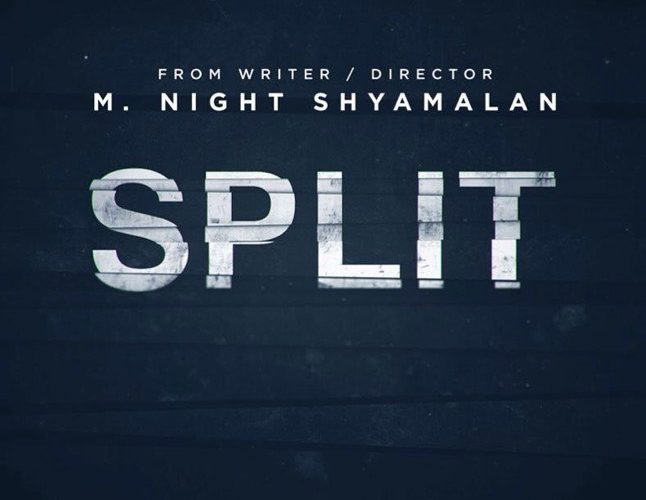M. Night Shyamalan movies are almost always better when he’s having fun. Like The Visit, Split makes mischief out of the balance between horror and comedy, continually throwing up situations that are simultaneously absurd and terrifying. The Visit exploited fears of the elderly, while Split goes to the popular well of insanity – specifically, dissociative identity disorder (better known as multiple personality disorder). There’s still controversy over whether DID is, in fact, a legitimate mental illness, but fiction loves it. Yet while Split takes DID to a more ridiculous extreme than most other depictions, the movie has a sympathetic core.
James McAvoy plays a man with 23 different identities. Two of them, “Dennis” and “Miss Patricia,” lead him to kidnap three teen girls and imprison them in an underground lair. The girls – Casey (Anya Taylor-Joy), Marcia (Jessica Sula), and Claire (Haley Lu Richardson) – are informed that they are offerings to “The Beast,” an emerging 24th identity that Dennis and Miss Patricia worship.

Split wrings plenty of suspense out of the girls’ attempts to escape, but they’re fairly secondary to exploring the man’s psychology. It’s as if Psycho didn’t spend its first half pretending Marion Crane was the protagonist. While other films might gradually unspool details of the man’s condition and plans from the girls’ point of view, here, the audience gets to see him interact with others – primarily his psychologist, Dr. Fletcher (a warm and professional Betty Buckley). The plot is not so much about the girls trying to survive as it is the mystery of who this man is and just what will happen when “The Beast” arrives.
Among other things, DID / MPD is a popular subject for film because of the acting challenge it presents, and McAvoy is full-bore on for it here. Somewhat disappointingly, though, his character has 23 personalities and we only get to meet a few of them. But it’s not as if playing around half a dozen different people in one body is anything to sneeze at. As Dennis, he’s chillingly stiff and precise. As Miss Patricia, he bears himself with smooth elegance. As the nine-year-old Hedwig, he’s a lisping, innocent goof. The real fun comes when it becomes evident that one of his identities is pretending to be another, and to then watch how he pulls off this act within an act. McAvoy is a campy, scary force of nature here.
Though Split’s portrait of DID is cartoonish, Shyamalan’s script uses the real-life psychological underpinnings of such conditions as an uncomfortably serious grounding. Like many real people with mental illness, his multiple identities are the result of childhood abuse, and he is manifesting dangerous personalities as a shield against further harm. Casey, meanwhile, is shown via flashback to have suffered similar trauma, which grants her a strange connection with him. Victimhood defines these characters, and worship of “The Beast” turns this into something sacred and transformative. In Split, it’s both terrifying and a source of power.

This brings forth some potent emotional peaks, but the hike there can be a chore. For a horror film with the ticking clock of captured young women awaiting doom, Split is aggravatingly talky at times. Scenes of the man talking to Dr. Fletcher in her upscale apartment quickly become repetitive, and at least a few of them could have been cut or condensed together. The girls’ escape attempts each play out in an utterly perfunctory manner – not even they seem to believe they’ll be getting anywhere before the third act. The problem with its mystery setup is that, since we’re simply waiting for The Beast to show up, the revelations are less driving plot progression than they are filling time, and that “ticking clock” is arbitrary.
And while Split may feel for its leads, that doesn’t mean some of its other ideas about victimhood aren’t still gross in the usual horror movie way. With Casey as the only “important” captive for the story’s purposes, the other two girls exist to be terrorized, including the man forcing both to strip down for no reason before they’re literally put out of sight and mind in other cells. Creating one-dimensional characters who exist to suffer for the sake of making the “real” lead’s danger feel more acute undermines any claim to empathy otherwise made therein.
In case you’re wondering: yes, there are Big Shyamalan Twists. The first is a good one, even though you might see it coming. It manifests Split’s themes in a visceral, enthralling way. The second… the second blindsided me; I let out a vocal “No way…” when the lead-up became clear. It’s absurd and results in one of my favorite endings of the year. It also ends the proceedings on a catastrophically bad note for what it’s trying to do — but, hey, you’ll sometimes trip when you dance between tones so much.
Split screened at AFI Fest 2016 and opens on January 20, 2017.

